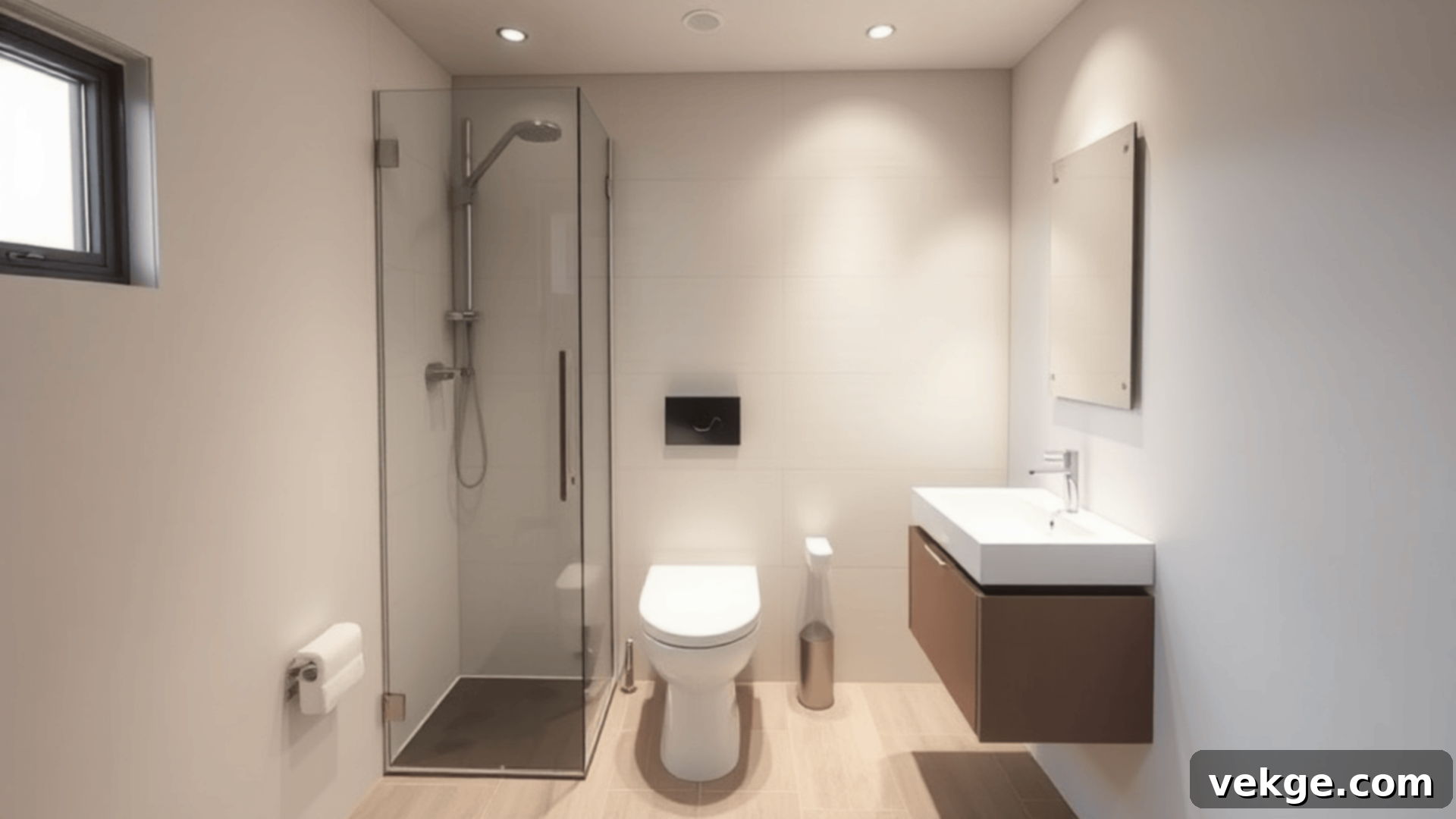Small Wet Room Ideas: Maximize Space & Style in Compact Bathrooms
Transforming a compact bathroom into a functional and stylish space can be a challenge, but small wet rooms offer an elegant and highly practical solution. By embracing the wet room concept, you can create an illusion of spaciousness, enhance accessibility, and introduce a modern aesthetic that elevates your home. These innovative designs eliminate the need for traditional bulky shower enclosures, making even the most confined bathrooms feel more open and inviting. From smart drainage to clever fixture choices, a well-designed small wet room demonstrates that limitations can be overcome with creativity and thoughtful planning.
Wet rooms are more than just a trend; they are a smart investment in comfort and convenience. Their seamless, open-plan design is not only visually appealing but also incredibly easy to clean. Furthermore, they provide a step-free showering experience, which is a significant advantage for individuals with mobility challenges, ensuring safety and independence. With proper waterproofing and meticulous attention to detail, a small wet room can be a durable, low-maintenance, and truly luxurious addition to any home, proving that size doesn’t have to compromise on functionality or style.
Essential Considerations Before Designing a Small Wet Room
Before diving into design specifics, it’s crucial to address several foundational elements to ensure your small wet room is both beautiful and functional. These considerations lay the groundwork for a successful and long-lasting installation.
- Proper Drainage & Waterproofing: This is the cornerstone of any wet room. A correctly sloped floor is paramount, directing all water towards a high-quality drain. Investing in premium waterproofing materials, such as tanking membranes and sealants, is critical to prevent leaks and protect the underlying structure of your home from moisture damage.
- Ventilation: Effective ventilation is key to controlling humidity and preventing mold and mildew growth. A powerful extractor fan is essential, ideally one that activates with the lights or has a humidistat. Proper airflow will keep your wet room feeling fresh, dry, and healthy.
- Space-Efficient Fixtures & Fittings: In a small wet room, every inch counts. Opt for wall-mounted sinks and floating toilets to free up floor space, creating a more open and uncluttered feel. Compact storage solutions, such as recessed niches or slimline cabinets, help maintain functionality without overwhelming the room.
- Durable & Safe Materials: The materials you choose must withstand constant moisture and offer safety. Non-slip tiles are crucial for flooring, providing traction even when wet. Waterproof wall panels, moisture-resistant paints, and durable, easy-to-clean finishes will ensure longevity and ease of maintenance, enhancing both safety and the room’s aesthetic appeal.
Innovative Floor Plans for Small Wet Rooms
Even with limited square footage, a variety of clever layouts can transform your small wet room into a highly efficient and aesthetically pleasing space. Here are some of the most effective floor plans, each designed to optimize functionality and flow.
1. Corner Shower Layout
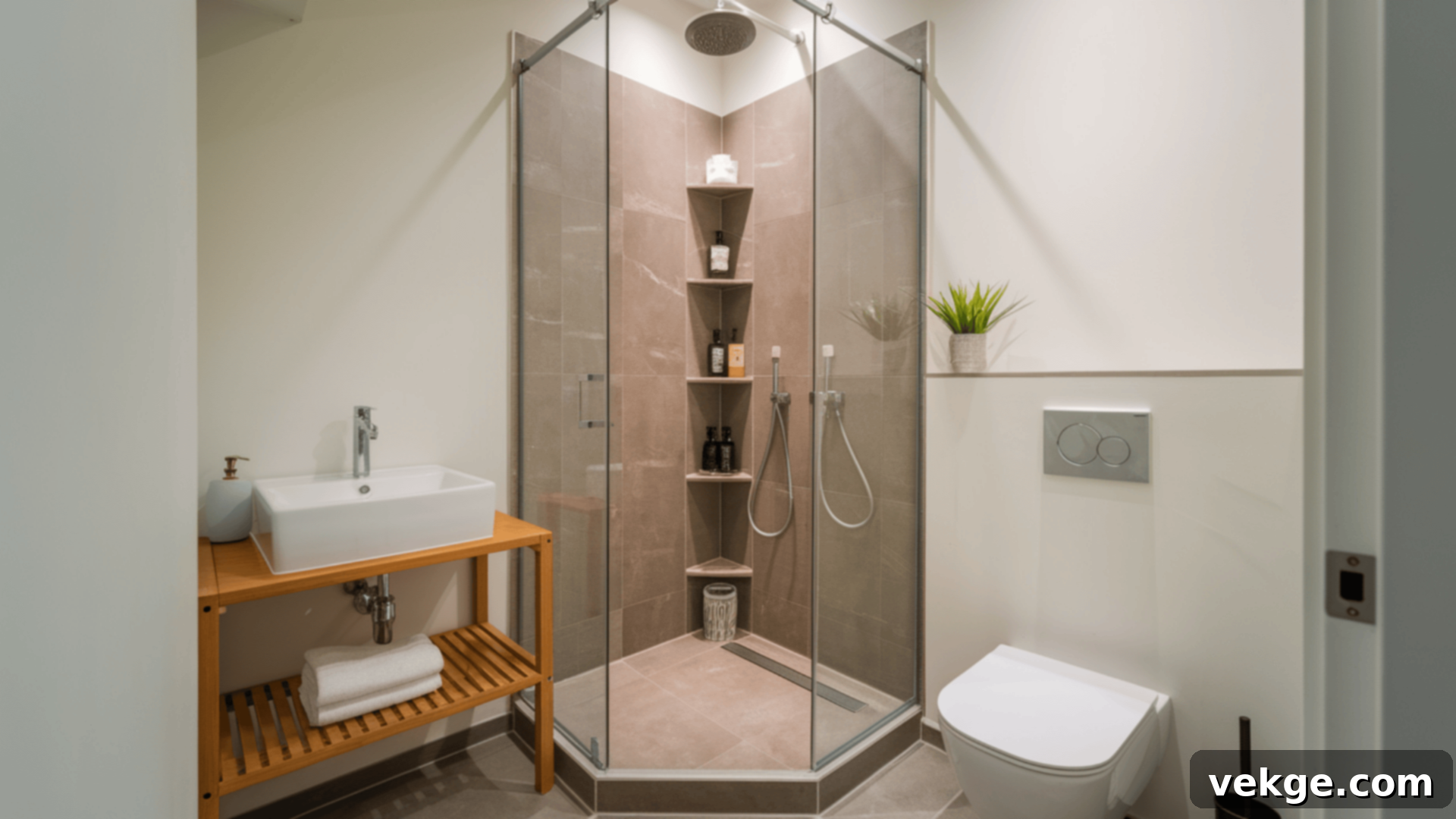
This layout ingeniously maximizes space by positioning the shower in a corner, thereby liberating the central area for other essential fixtures like the toilet and sink. It’s an ideal choice for the smallest bathrooms, where every centimeter must be utilized efficiently. This design maintains a functional flow, making the room feel more spacious and less cramped, while still providing a comfortable showering experience.
2. Linear Layout
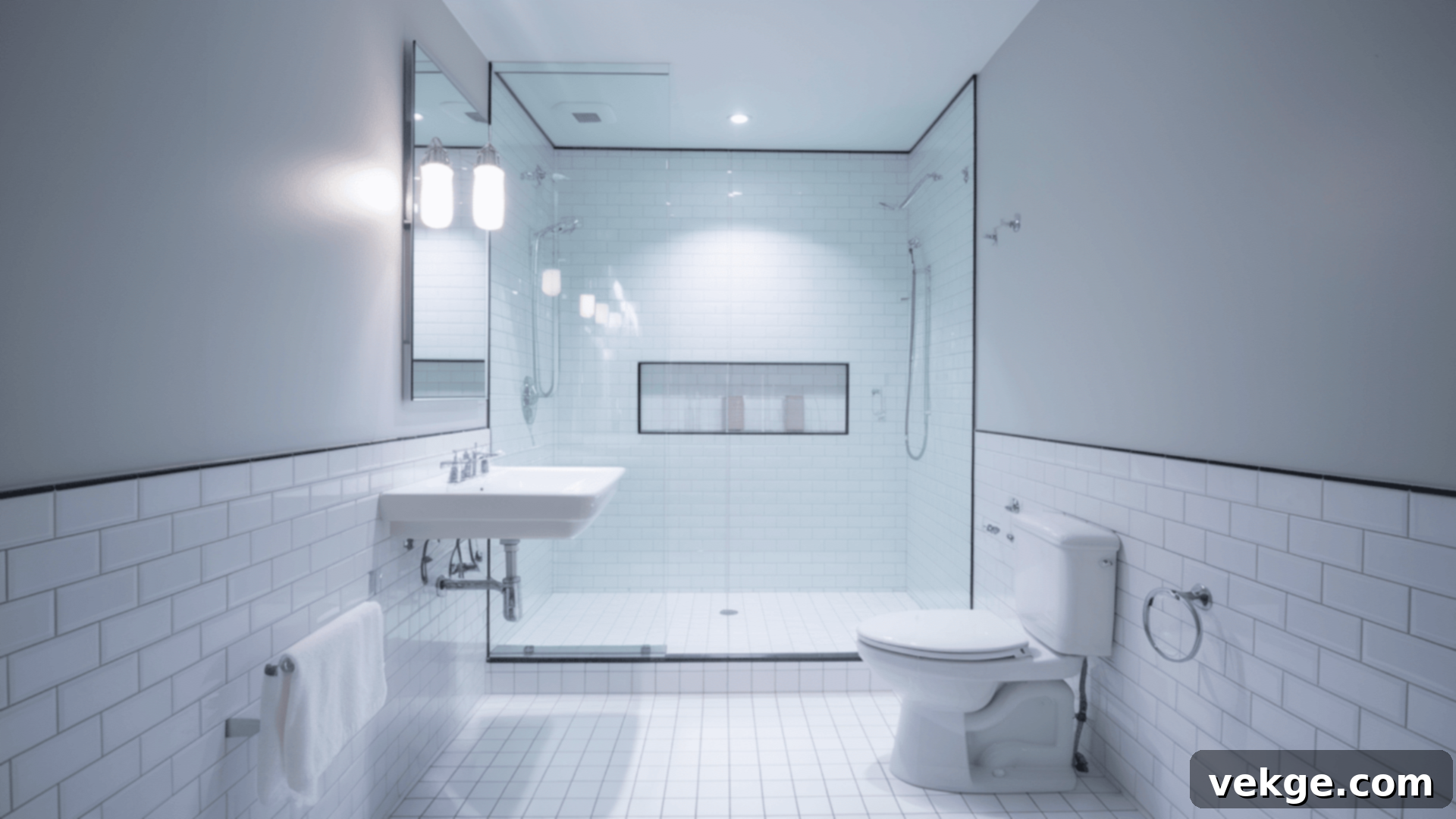
The linear layout arranges all fixtures – shower, toilet, and sink – in a straight line along one wall. This minimalist and highly efficient design is particularly well-suited for narrow or rectangular wet rooms. It ensures an uncluttered and streamlined look, allowing for easy movement between different zones and preventing any sense of congestion. This layout emphasizes simplicity and functionality, making it a popular choice for modern small bathrooms.
3. Walk-In Wet Room
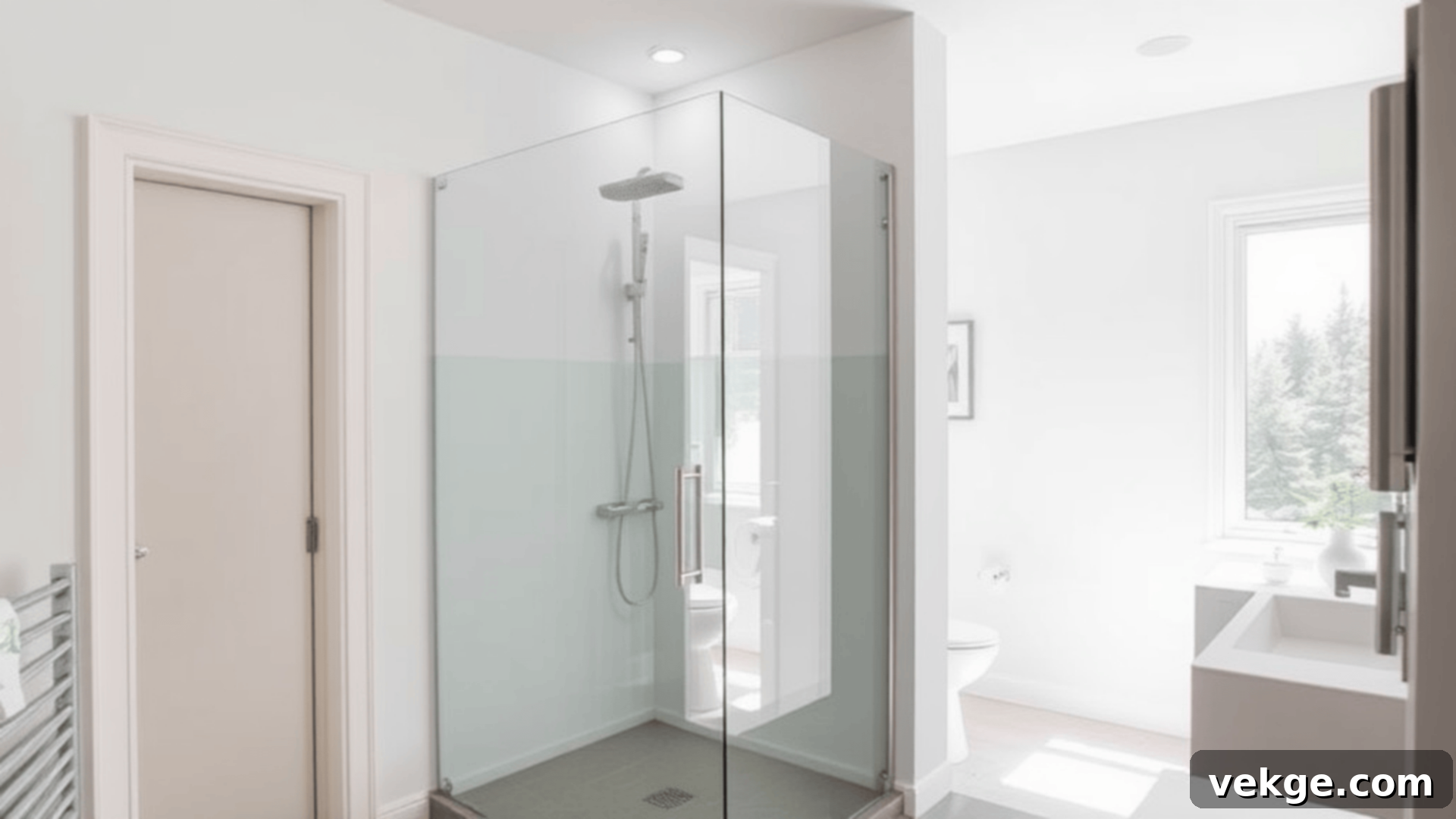
Featuring an open-concept design, the walk-in wet room often incorporates a partial glass partition to offer subtle water control without fully enclosing the shower area. This design inherently creates a more spacious and airy feel, making even the smallest wet rooms appear larger and more inviting. It offers a contemporary and sophisticated aesthetic, blending seamlessly into modern home designs while providing practical functionality.
4. Compact Enclosed Wet Room
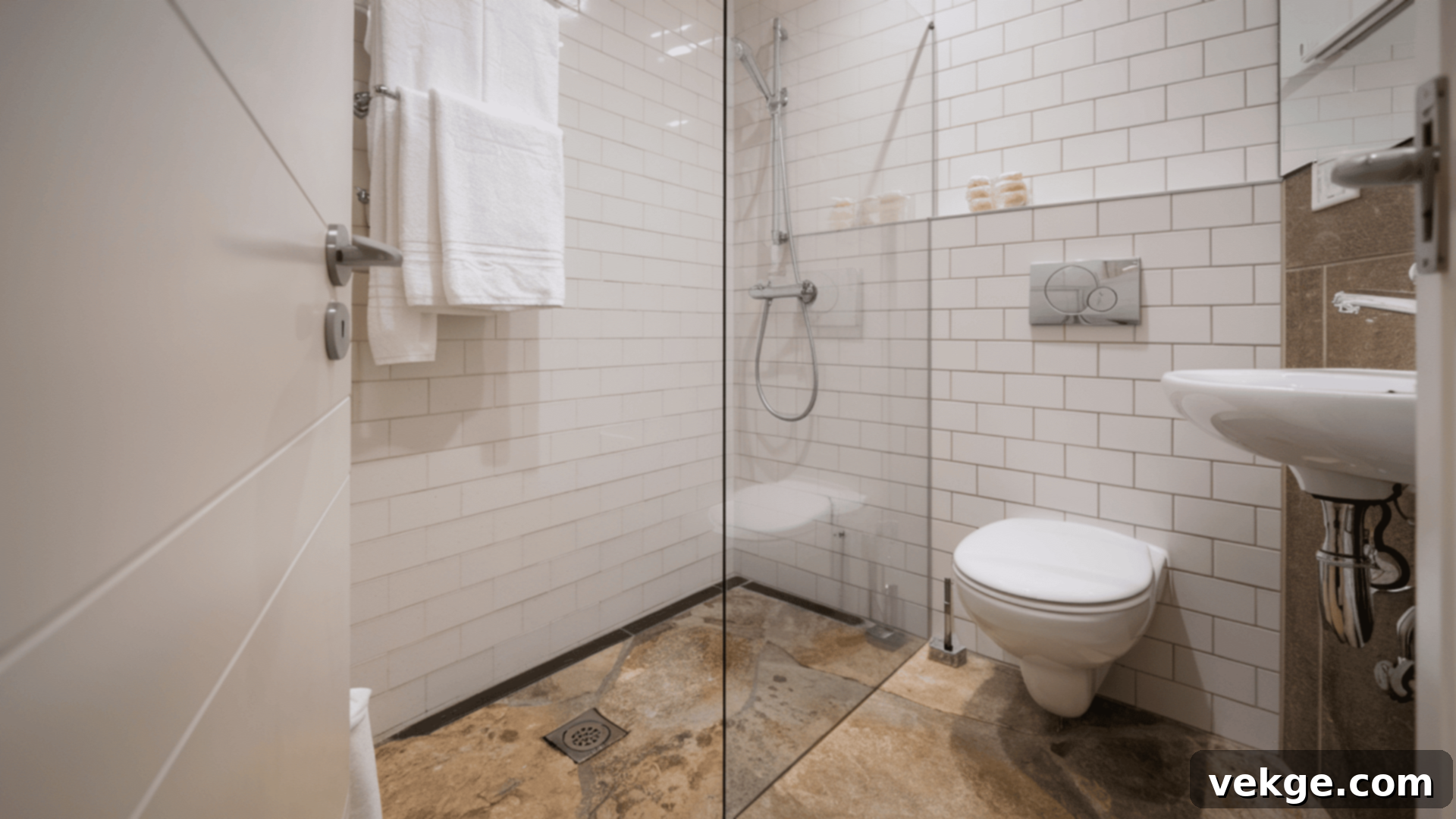
For those prioritizing maximum water containment, a compact enclosed wet room is an excellent choice. This layout typically features a full glass door or paneling to fully enclose the shower area, effectively preventing splashing into the rest of the bathroom. While offering superior water control, this design still maintains a sleek and modern appearance, ensuring that dry areas remain clean and moisture-free, which is particularly useful in family homes.
5. L-Shaped Layout
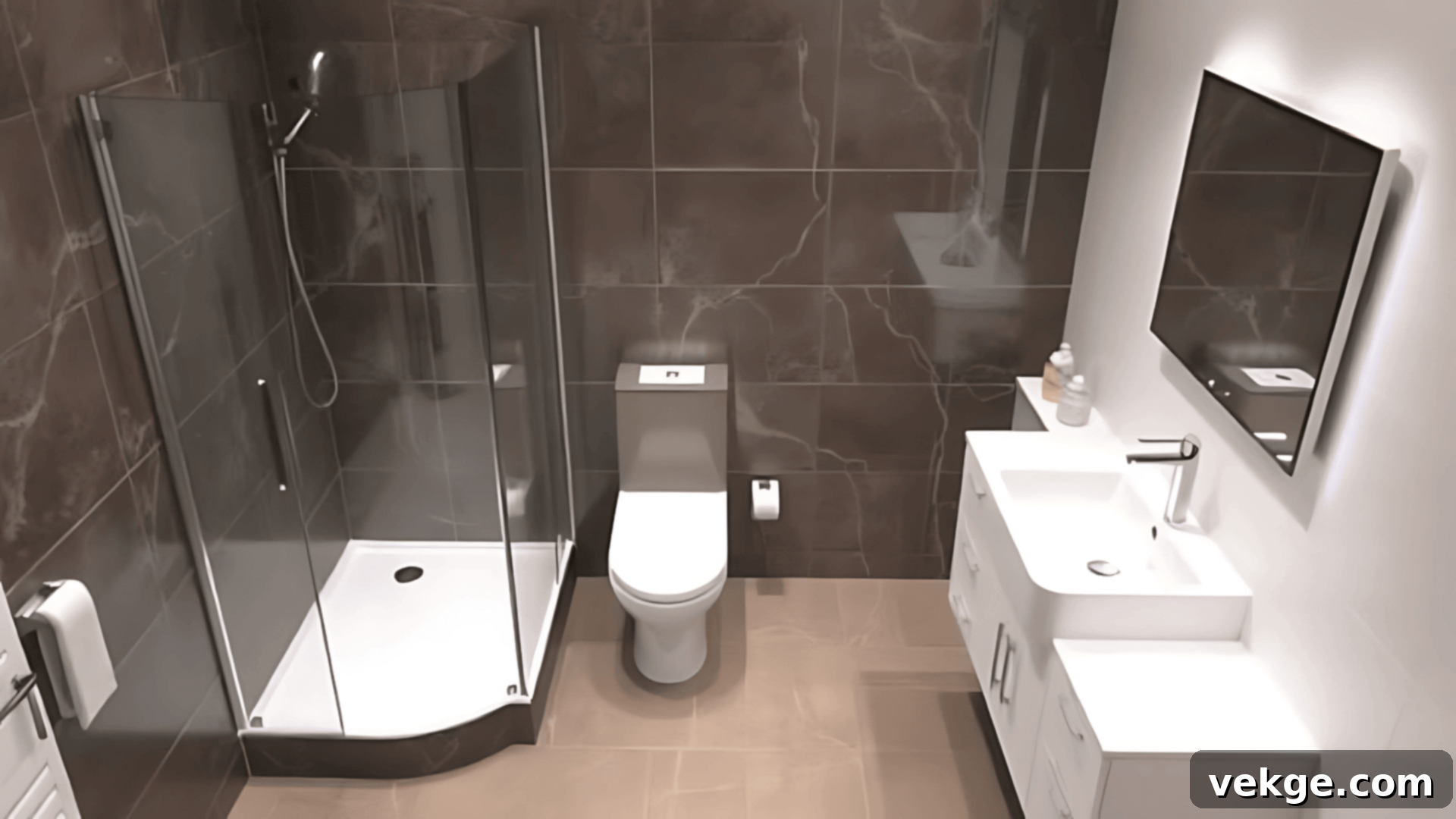
The L-shaped layout is designed to strategically separate the shower from the toilet and sink areas, enhancing both functionality and perceived flow within the room. By defining distinct wet and dry zones, it maximizes privacy and creates a more organized and harmonious space. This layout is perfect for achieving a smooth transition between different functional areas, making a small wet room feel larger and more purposeful.
6. Doorless Wet Room
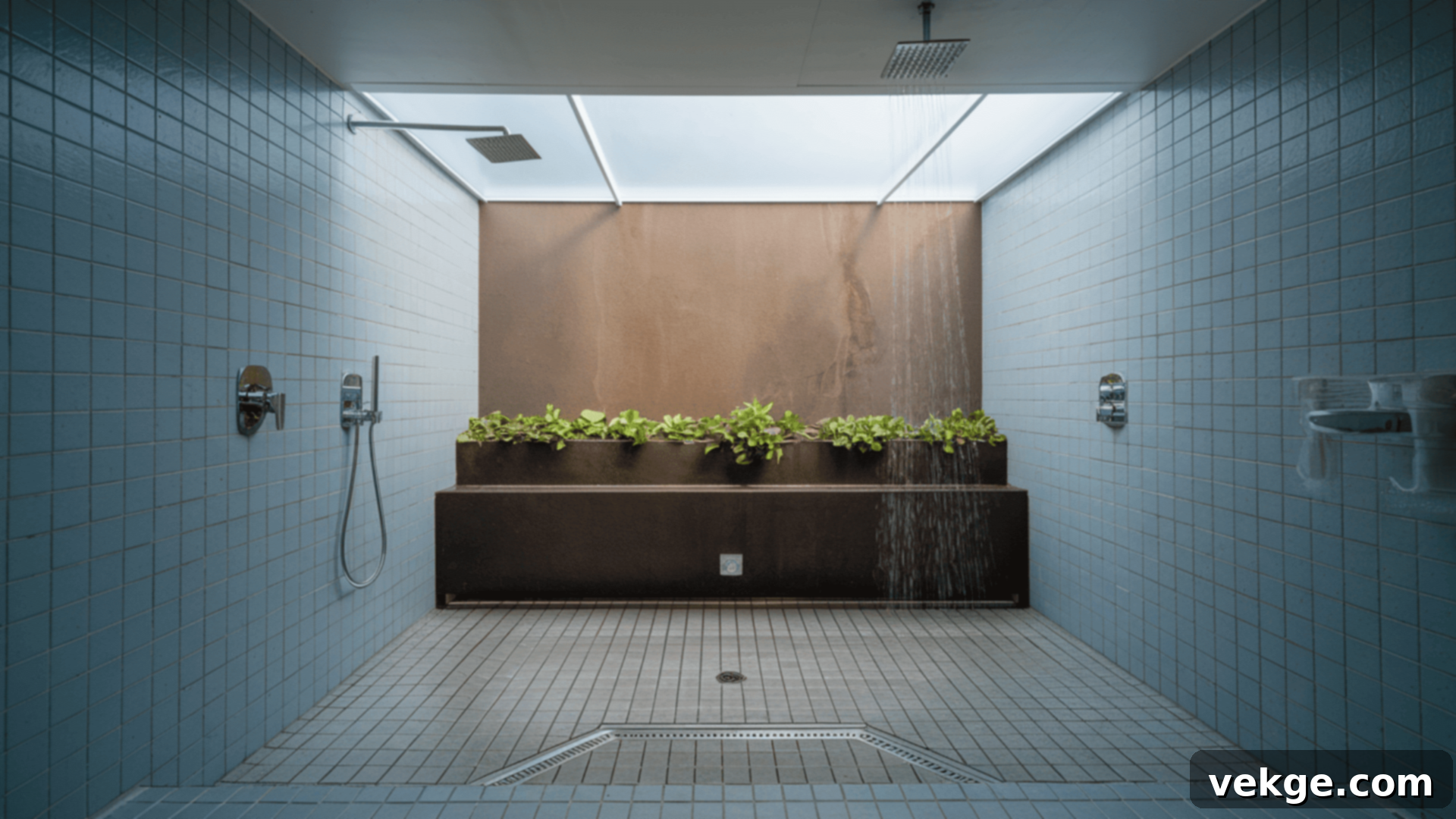
A doorless wet room eliminates the need for any physical barriers by relying on intelligent drainage and superior waterproofing. This design significantly enhances accessibility, creating a truly seamless and open aesthetic that makes the entire space feel expansive. With a well-planned sloped floor and strategically placed drains, water is effectively contained, offering a minimalist yet highly functional showering environment.
7. Split-Zone Layout
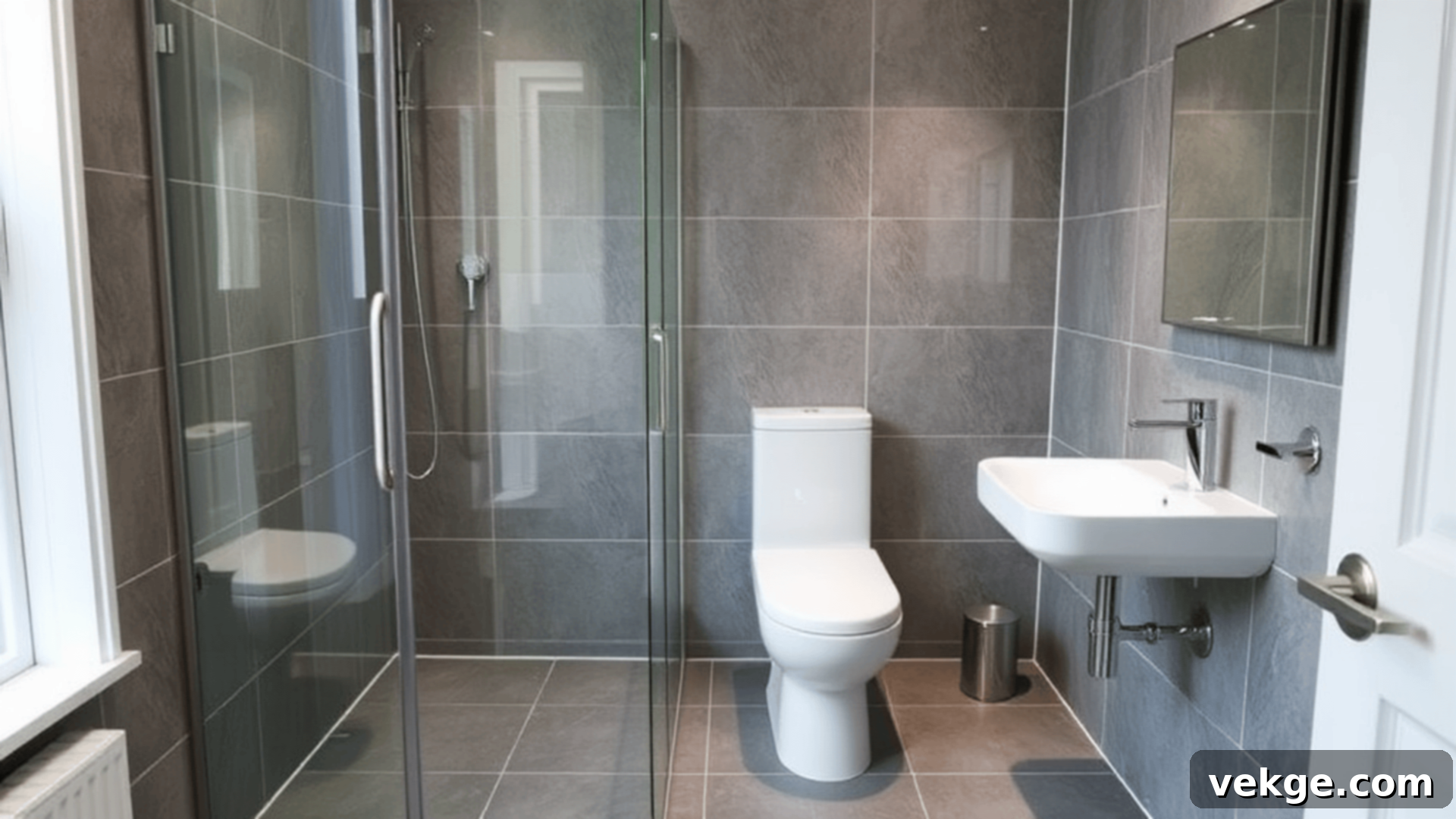
The split-zone layout aims to clearly divide the wet and dry areas, significantly improving usability and ensuring that non-shower regions remain dry. By designating a specific zone for showering, this design prevents excessive water spread, making it an exceptionally practical choice for small wet rooms, especially those experiencing higher foot traffic. It balances openness with effective water management.
8. Narrow Wet Room
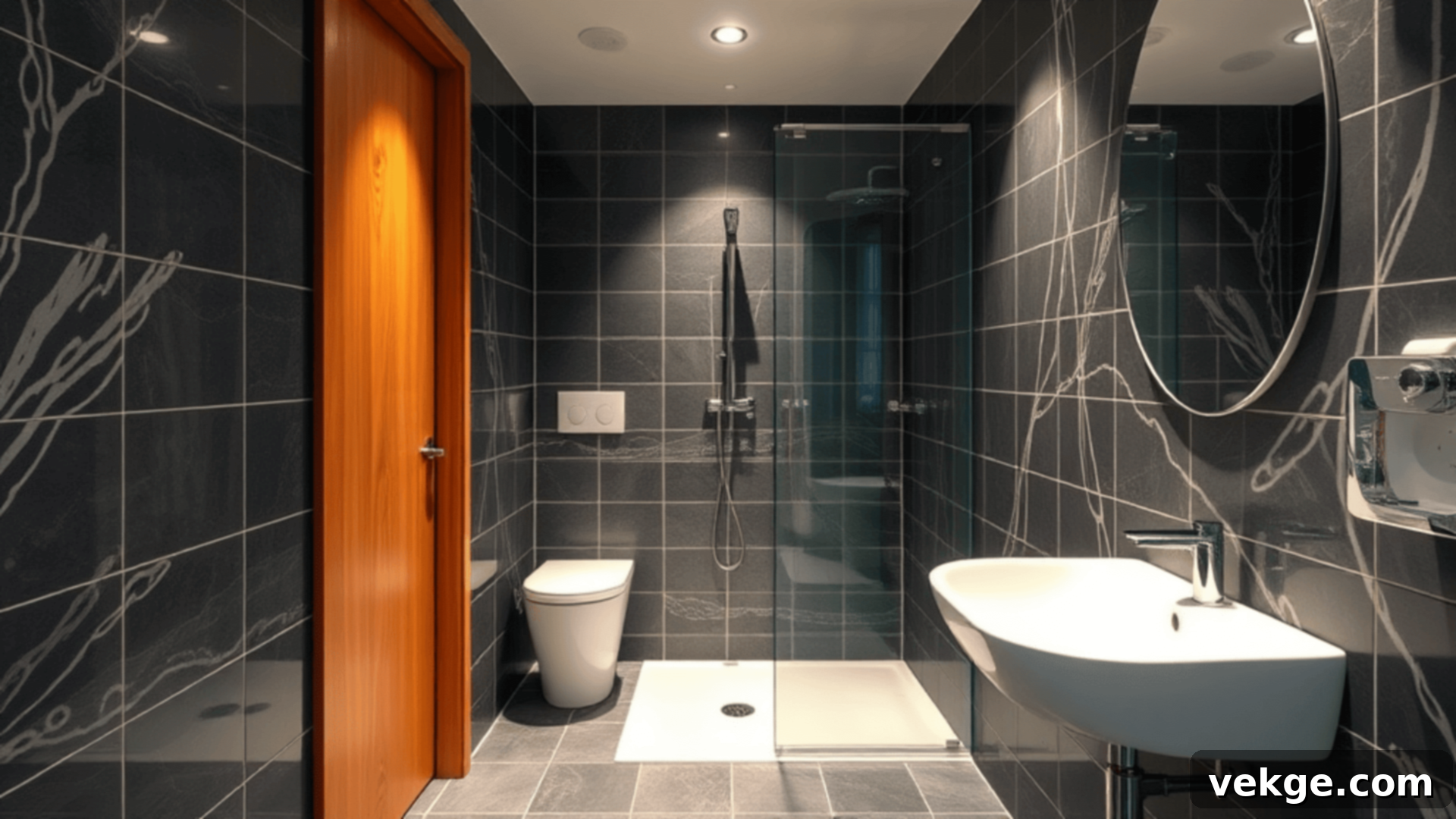
Specifically designed for long, slim spaces, this layout typically places the shower at one end, optimizing movement and circulation in tight areas. It ensures that the available width is fully utilized, transforming an otherwise challenging space into a highly functional and visually appealing wet room. This design is about making the most of a specific architectural constraint.
9. Floating Fixtures Layout
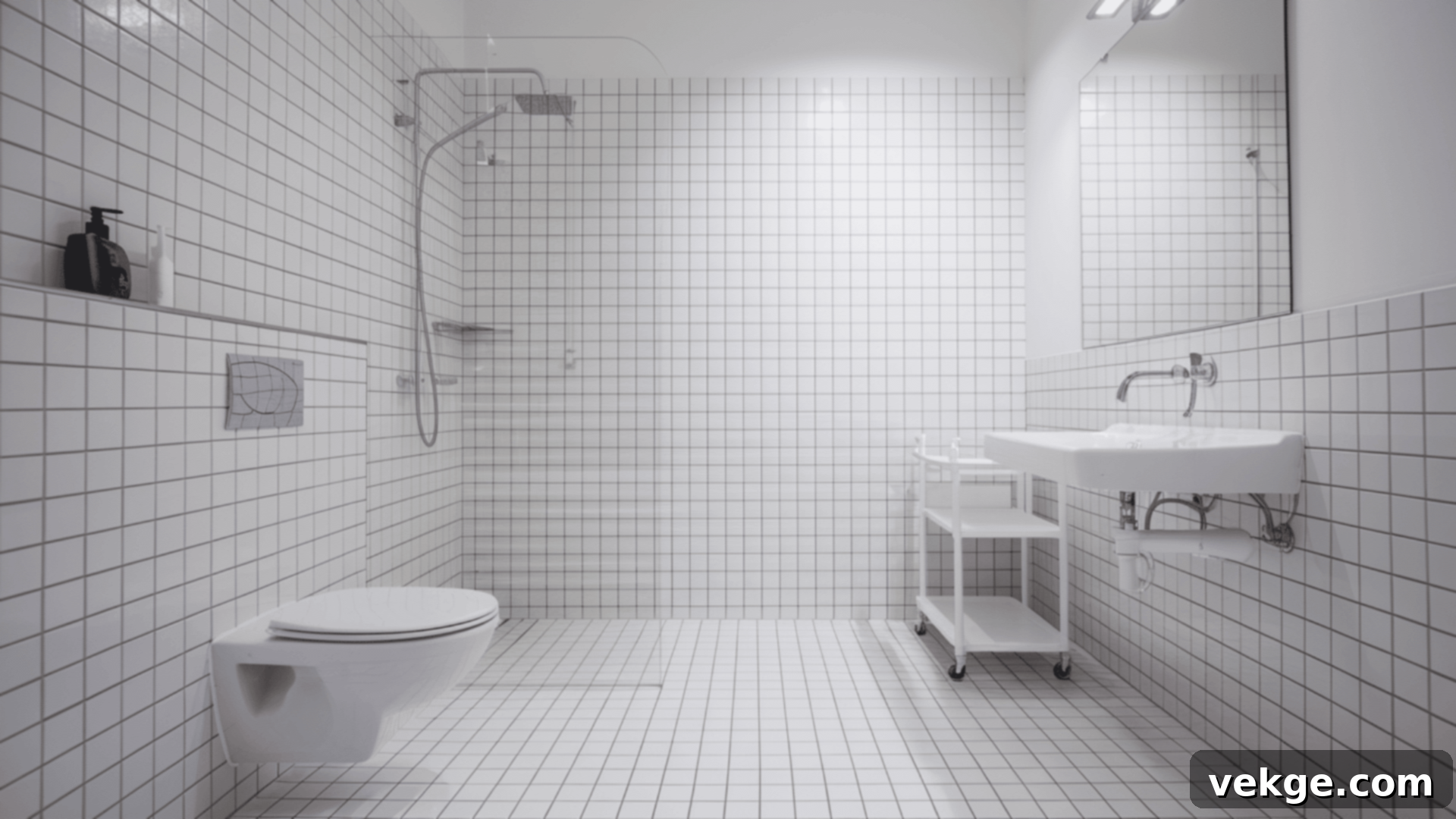
This innovative layout leverages wall-mounted toilets and sinks to completely free up floor space. The result is a dramatically enhanced sense of openness and improved accessibility. By keeping the floor clear, it creates an illusion of greater spaciousness, simplifies cleaning, and even allows for discreet under-sink storage options, contributing to a minimalist and highly efficient design.
10. Glass-Enclosed Nook
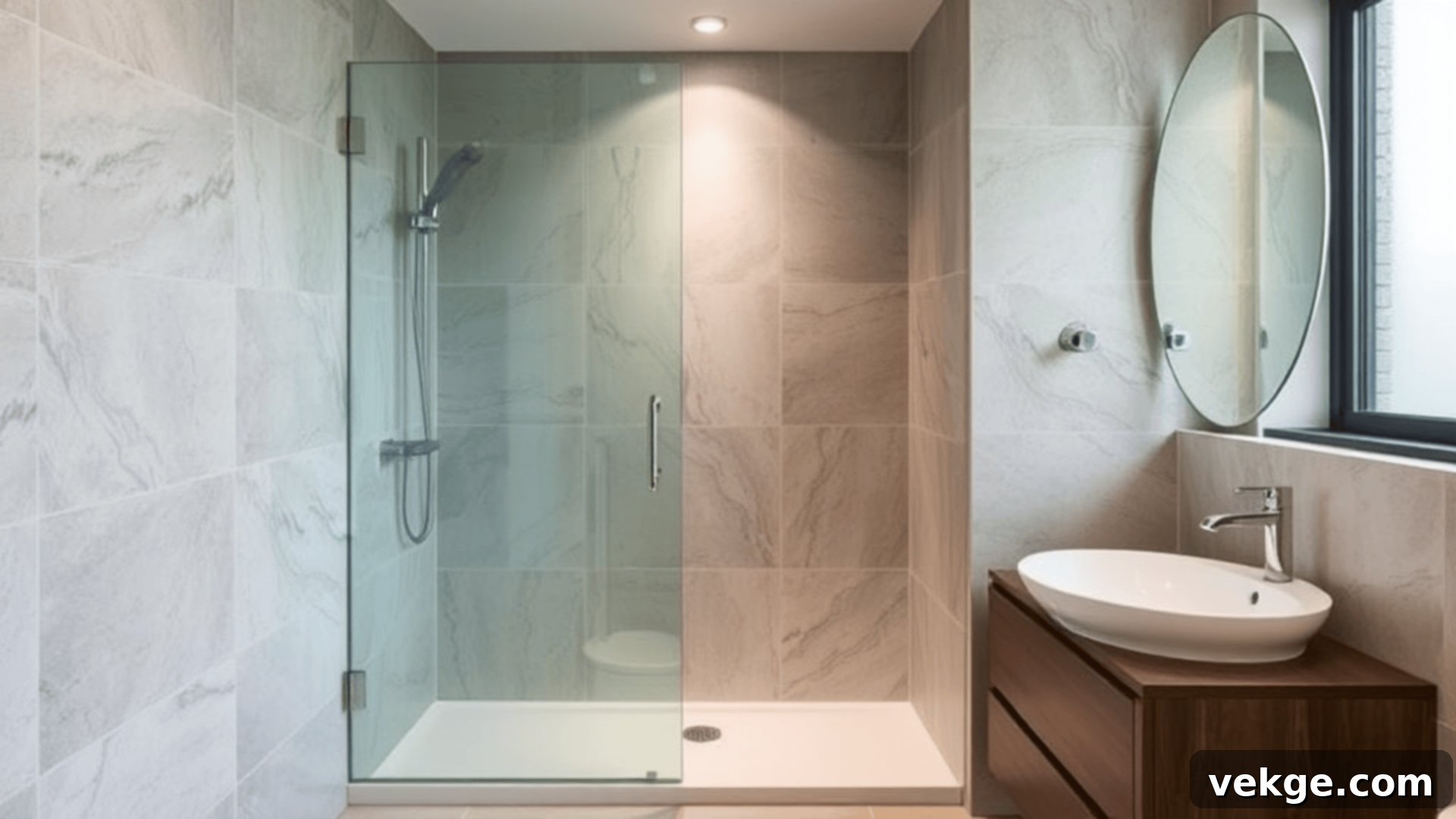
Featuring a partial or full glass panel, this layout effectively contains water spray without fully enclosing the shower area. It strikes a perfect balance, maintaining an open and airy feel while offering practical water control. This makes it an excellent choice for those who desire both the spaciousness of a wet room and the distinct separation of a traditional shower, blending aesthetics with functionality.
11. Minimalist Open Wet Room
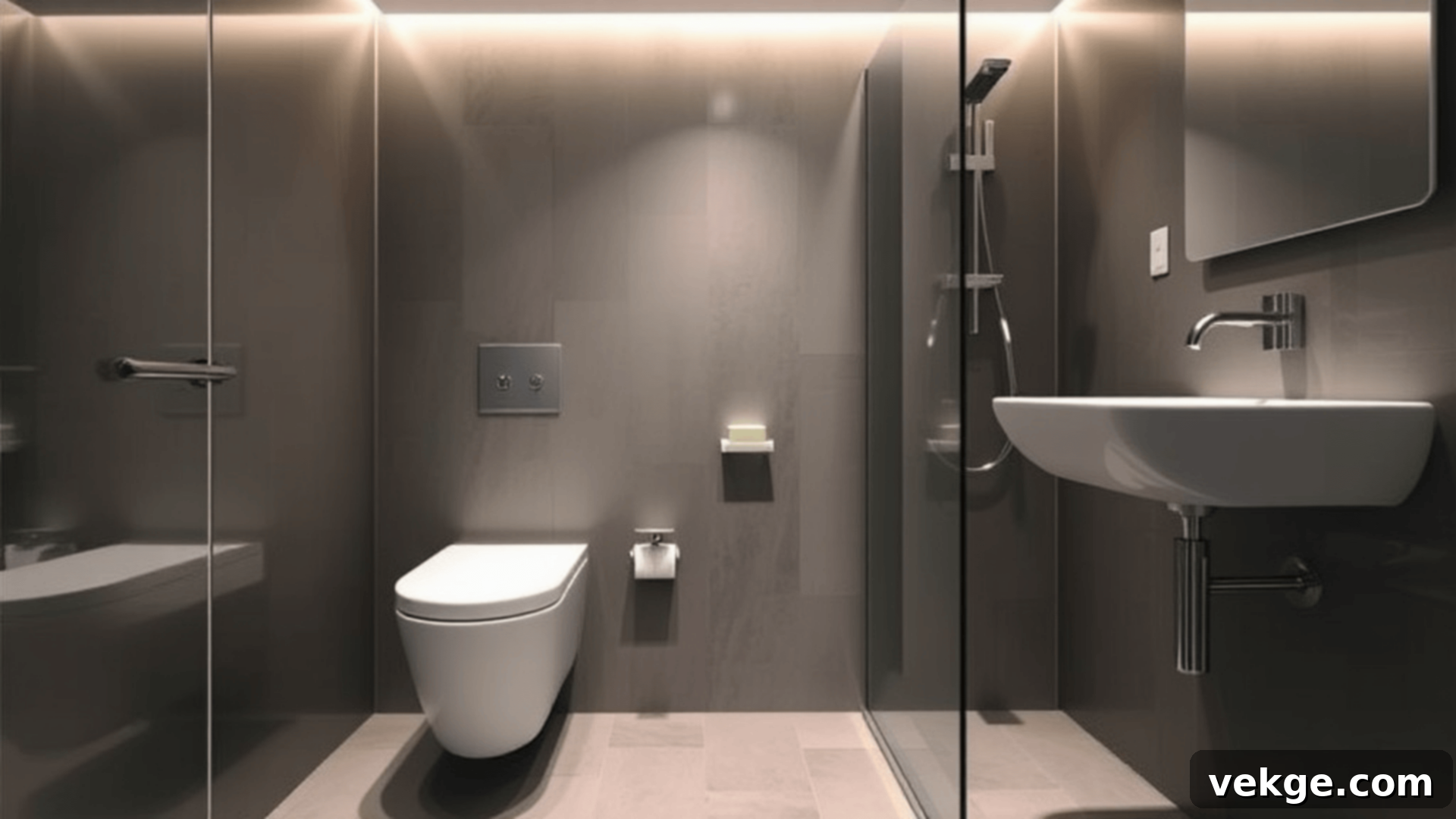
This design embraces ultimate simplicity, offering a fully open shower space that relies entirely on proper drainage for a seamless and ultra-modern look. By eliminating all physical barriers, it creates a visually expansive area, making the room feel incredibly spacious and uncluttered. With a meticulously planned floor slope and high-quality waterproofing, this layout ensures effective water control while celebrating a serene, minimalist aesthetic.
Smart Space-Saving Tips for Small Wet Rooms
Maximizing space is paramount in a small wet room. Implement these smart design choices to ensure your compact bathroom feels as expansive and functional as possible.
- Use Wall-Mounted or Floating Fixtures: Wall-hung toilets and sinks instantly free up floor space, making the room appear larger and much easier to clean. The absence of visible plumbing also contributes to a cleaner, more minimalist look.
- Install Recessed Shelving: Built-in niches or recessed shelving provide discreet storage for toiletries and other essentials without protruding into the room. This clever solution keeps surfaces clutter-free and maintains an open aesthetic.
- Opt for Clear Glass Panels: When partitions are necessary, choose frameless or minimal glass dividers. Their transparency helps maintain visual continuity, preventing the space from feeling segmented or closed off.
- Choose Light-Colored Tiles: Bright, neutral tones like white, cream, or light grey reflect light, making the room feel significantly larger and airier. Consistent color choices across walls and floors further enhance this effect.
- Incorporate Multifunctional Fixtures: Consider compact vanity units that combine a sink with storage, or showerheads that integrate body jets. Every fixture that serves multiple purposes helps reduce the overall number of items needed.
- Utilize Sliding or Pocket Doors: Traditional swinging doors consume valuable floor space. Sliding doors that glide along the wall or pocket doors that disappear into the wall are excellent space-saving alternatives, enhancing accessibility and flow.
- Use Large Format Tiles: Fewer grout lines create a more seamless and uninterrupted look, reducing visual clutter and making the room appear more expansive. This also simplifies cleaning.
- Install Floor-to-Ceiling Mirrors: Mirrors are powerful tools for expanding a small space. A large mirror reflects light and the room itself, enhancing depth and brightness, effectively doubling the perceived size of your wet room.
- Keep Decor Minimal: Overcrowding with excessive accessories can make a small space feel even smaller. Embrace a minimalist approach with only essential items to maintain an uncluttered and open layout.
Challenges & How to Overcome Them in Small Wet Rooms
Designing a small wet room comes with specific challenges, but with smart planning, each can be effectively overcome to create a perfectly functioning space.
Prevent Water from Splashing into Dry Areas
Controlling water splash is crucial for maintaining comfort and hygiene in a wet room. Consider installing a glass partition or a partial enclosure that extends sufficiently to contain the shower spray. These barriers are highly effective at keeping water within the designated wet zone while still maintaining an open feel. Additionally, a meticulously sloped floor, designed to direct all water towards the drain, is non-negotiable. Installing a well-placed linear drain, which can handle a higher volume of water and guides flow efficiently, further ensures that water flows away from dry spots and prevents pooling in unwanted areas. Thoughtful placement of showerheads can also minimize splashing.
Ensuring Proper Ventilation to Reduce Humidity
High humidity is the enemy of any bathroom, especially a wet room, leading to mold, mildew, and potential structural damage. Proper ventilation is paramount. Installing a powerful extractor fan, rated for the size of your wet room, will significantly improve air circulation and prevent moisture buildup. Look for fans with a humidistat or timer function for optimal performance. Furthermore, using moisture-resistant paint and materials on walls and ceilings adds an extra layer of protection against mold and mildew. Whenever feasible, keeping windows or vents open during and after use allows fresh air to circulate naturally, further reducing humidity and helping the space dry out completely.
Selecting Non-Slip Tiles for Safety
Safety should always be a top priority in a wet environment. When choosing bathroom tiles, opt for those with a textured or matte finish, as they inherently provide better grip, especially when wet. Always look for slip-resistant tiles that are specifically rated for wet areas (e.g., a high R-value for barefoot wet areas). These ratings indicate the level of slip resistance. Using smaller mosaic tiles is another excellent option because they offer more grout lines. The increased surface area of grout acts as additional traction, significantly minimizing the risk of slips and falls, making your wet room safer for everyone.
Maximizing Storage Without Clutter
In a small wet room, maximizing storage while avoiding clutter is essential for a clean, organized, and tranquil space. Built-in recessed shelving, or niches, are a brilliant way to store toiletries and other essentials without taking up any visible room. These can be artfully integrated into shower walls or other convenient locations. Floating cabinets or wall-mounted hooks are excellent choices for keeping items off the floor and maintaining an open, airy feel. Furthermore, utilize waterproof baskets or stylish organizers for smaller items. These can keep everything tidy, dry, and easily accessible, contributing to a minimalist and functional design.
Dealing with Limited Space
The inherent challenge of a small wet room is, of course, its limited space. The key to success lies in making thoughtful choices. Opt for compact, space-saving fixtures that are proportional to the room and won’t overwhelm it. Installing a wall-mounted or corner sink, for example, can free up valuable floor space, instantly making the room feel more expansive and open. Adopting a minimalist layout and design philosophy is critical to avoiding overcrowding. By keeping only essential elements and embracing clean lines, the space remains highly functional while maintaining an uncluttered and serene aesthetic. With such deliberate choices, even the most compact wet rooms can achieve both efficiency and undeniable style.
Budget-Friendly Design Ideas for Small Wet Rooms
Creating a beautiful and functional wet room doesn’t have to break the bank. Here are some smart, budget-friendly ideas to achieve a high-end look without the high-end cost:
- Waterproof Paint: Instead of expensive wall panels or full tiling, use high-quality waterproof or moisture-resistant paint. This is an affordable and effective way to protect walls from water damage, offering a fresh, clean look at a fraction of the cost.
- Waterproof Membranes: While not a visible design element, installing waterproof membranes beneath your tiles or paint is a crucial and cost-effective step. They are relatively easy to install and provide a highly effective barrier against water damage, preventing costly repairs down the line.
- Shower Trays: Opting for a slimline or level-access shower tray rather than fully tanking the entire floor can save significantly on labor and material costs. These trays provide a solid, water-resistant surface and are much quicker to install, while still offering a sleek, minimalist aesthetic.
- Floating Shelves: Simple floating shelves are an economical yet stylish solution for storage. They help save floor space and keep toiletries off the countertop, contributing to an open, organized, and modern feel without the expense of built-in cabinetry.
- Suction-Cup Organizers: For immediate, no-installation storage, suction-cup organizers are a fantastic budget option. They’re perfect for holding shampoo, soap, and other shower essentials, keeping them off the floor and within easy reach, and can be easily repositioned.
- Ladder Shelves: A freestanding ladder shelf offers a unique and modern touch for towel storage or decorative items. It’s a stylish, practical, and portable solution that adds visual interest without permanent installation or high cost.
- Wall-Mounted Sink: A compact, wall-mounted sink is typically less expensive than a vanity unit. It frees up floor space, creating a cleaner and more spacious look in smaller bathrooms, contributing to the minimalist wet room aesthetic.
- Modern Fixtures: You don’t need designer brands to achieve a modern look. Many affordable retailers offer sleek, contemporary taps, showerheads, and accessories that can instantly update your bathroom’s appearance without a hefty price tag.
- Peel-and-Stick Tiles: For a quick and affordable aesthetic upgrade on walls (outside the direct splash zone) or even as an accent, peel-and-stick tiles can offer a fresh, updated look without the mess or cost of traditional tiling and installation.
Cleaning & Maintenance Tips for Your Small Wet Room
Maintaining the pristine condition and longevity of your small wet room is simple with a consistent cleaning routine. These tips will help keep your space sparkling and prevent common issues.
Best Cleaning Products for Wet Room Surfaces
- Use Mild, Non-Abrasive Cleaners: Always opt for gentle, pH-neutral cleaners to protect the delicate surfaces of your tiles, grout, and fixtures. Harsh chemicals can degrade sealants and dull finishes over time.
- Opt for Vinegar and Water Solutions: For a natural and effective disinfectant, a solution of white vinegar and water is excellent. It’s great for tackling water spots, soap scum, and light mildew without strong chemicals.
- Choose Anti-Bacterial Sprays: Regular use of anti-bacterial or anti-fungal sprays can prevent grime and mold buildup, especially in corners and grout lines, ensuring a hygienic environment.
Preventing Mold and Mildew Buildup
- Wipe Down Wet Surfaces After Each Use: A quick wipe-down of tiles and glass panels with a squeegee or microfiber cloth after showering significantly reduces moisture, which is the primary cause of mold and mildew.
- Keep Ventilation Fans Running or Windows Open: Ensure your extractor fan runs for at least 15-20 minutes after showering, or keep windows open to allow for proper airflow and humidity reduction.
- Use Mold-Resistant Grout and Sealants: When installing or re-grouting, choose products specifically formulated with mold inhibitors for long-term protection against fungal growth. Re-seal grout annually if recommended.
Quick Daily Maintenance Routines
- Squeegee Glass Panels and Tiles: A swift squeegee across glass partitions and tiled walls prevents water spots and soap scum from drying, keeping surfaces crystal clear.
- Check and Clear Drains: Regularly check your wet room drain for hair or soap buildup and clear it promptly. This prevents blockages and ensures efficient water flow, avoiding standing water.
- Keep a Microfiber Cloth Handy: Having a dedicated microfiber cloth nearby encourages quick wipe-downs of surfaces and fixtures, addressing minor spills or splashes immediately and contributing to overall cleanliness.
Conclusion
A well-designed small wet room is a testament to the power of intelligent planning and creative execution. It effortlessly transforms a tight space into a highly practical, accessible, and exquisitely stylish bathroom. By meticulously considering key elements such as robust waterproofing, effective ventilation, and space-saving fixtures, you lay the foundation for a durable and delightful environment. The choice of layout—whether a compact corner shower, a streamlined linear setup, or an expansive open-concept design—plays a pivotal role in maximizing every inch while maintaining optimal functionality and visual appeal.
Ultimately, good planning ensures that water drains properly, moisture is effectively managed, and storage is utilized with unmatched wisdom. This thoughtful approach extends beyond mere aesthetics, contributing significantly to the comfort, safety, and long-term value of your home. With smart design choices and a commitment to quality materials, even the most modest bathroom can shed its limitations, feeling surprisingly spacious, effortlessly comfortable, and undeniably luxurious. Embrace the potential of your compact space; a stunning and functional wet room awaits. For more home improvement ideas and innovative design solutions, explore similar content on our website!
